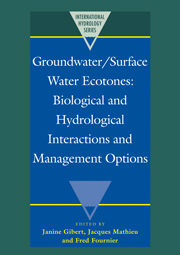Book contents
Preface
Published online by Cambridge University Press: 07 September 2010
Summary
When the UNESCO research programme on Man and the Biosphere was launched in 1971, aquatic ecosystems immediately became the subject of a special project due to the important changes that can be produced in them by human activities. In the beginning, attention was focused on the consequences of intensification of agriculture: erosion and sedimentation, groundwater pollution, eutrophication, and other adverse events.
After 15 years, the first phase of the project was concluded with a final meeting devoted to the use of scientific information in understanding the impact of land use on aquatic ecosystems. It highlighted the major role of interfaces (ecotones) between terrestrial and aquatic ecosystems in the regulation of biogeochemical cycles and in the structuring of landscape mosaics. Viewing aquatic systems as a collection of resource patches separated by ecotones allows to determine the relative importance of upstream – downstream linkages, lateral linkages and vertical linkages to be examined, and provides a conceptual framework for the understanding of factors regulating the exchange of energy and materials between identifiable resource patches.
Therefore, it was recommanded by this meeting that UNESCO's future work on ecosystems should emphasize the in-depth study of ecotones, their management and restoration. Thus the Ecotone project was established under the double responsability of the International Hydrological Programme and the Man and Biosphere Programme with a general objective to determine the management options for the conservation and restoration of the land/inland water ecotones through increased understanding of ecological processes.
- Type
- Chapter
- Information
- Groundwater/Surface Water EcotonesBiological and Hydrological Interactions and Management Options, pp. xiii - xivPublisher: Cambridge University PressPrint publication year: 1997

